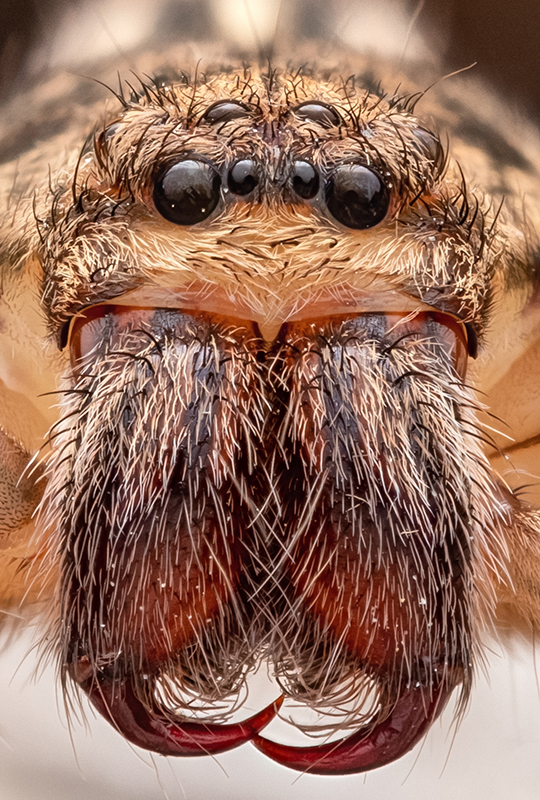Insects may be lacking in size, but they sure aren’t lacking in personality. Spend an hour or two in your local garden to uncover their fascinating behaviours, such as hunting for prey, foraging and even mating. Oh - and while you’re at it, bring along your Canon camera and look out for these 5 exciting moments to photograph!
This article is supplemented with images by Abdul Gapur Dayak (@abdulgapurdayak) and Khevan (@khe1shoots).
Everyday Interactions
 Red ant relocating larvae
Red ant relocating larvae
Canon EOS 7D, EF100mm f/2.8 Macro USM, f5, ISO 160, 1/125s, 100mm
The image above was taken near a fallen ant nest where worker ants were scurrying to save their next generation of ants. For such images, the beauty lies in the learning of their behaviours and patterns. An instinctual behaviour such as relocating their larvae when met with danger shows how they manoeuvre and overcome obstacles. If you’re particularly interested in ants, you can also look out for images of them foraging for food with their mandibles (an action-packed shot) or unique behaviours such as Necrophoresis (the practice of removing and dumping dead ants) and more.
Tip: Follow the ant trail and be patient. You’re almost guaranteed to find something interesting from these hardworking subjects.
 Stacked cicada moults
Stacked cicada moults
Canon EOS 7D, EF100mm f/2.8 Macro USM, f5, ISO 200, 1/60s, 100mm
Additionally, don’t overlook carcasses or exoskeletons of insect moults! They can make for fascinating images, especially because they are inanimate objects, so you can move them around to create an artistic shot like the one above.
Try photographing during dawn to incorporate mesmerising dewdrops in your insect photos!
Colour Pop

Praying mantis
Canon EOS 200D, EF-S60mm f/2.8 Macro USM, f10, ISO 200, 1/250s, 60mm
The insect kingdom is a bustling realm of its own, and most occupants have striking hues meant for both defensive and offensive purposes. So, what better way to showcase that pop of colour than a plain black background? The black background in macro photography is achieved through the use of flash. When the subject is illuminated using a flash it becomes much brighter than the background. This causes the camera to adjust its exposure as per the brightness of the subject and the background goes dark.
Photographer’s note: praying mantises are usually very cooperative subjects since they do not move around much nor jump very far. They are pretty easy to handle and will gladly stay perched on top of a stick until they find another platform to grab.
Tip: Try to keep your movements slow and steady to avoid spooking them during the shoot.
Strike a Pose

Praying mantis in a defensive pose
Canon EOS 7D, EF100mm f/2.8 Macro USM, f5, ISO 250, 1/60s, 100mm
Photograph insects in action or with flattering angles through the positioning of your camera to add more interest to the shot. For example, butterflies resting with their wings open can reveal a design that is hidden when closed. Another example could be to photograph the side profile of a caterpillar to showcase its unique pattern. When spooked out, predatory insects like the praying mantis can switch to a defensive pose that can be quite charming to photograph. However, we do not recommend causing distress to the insect for a mere photo. Always respect mother nature!
Tip: Use bokeh to blur out any unnecessary elements in the background with manual focus to keep the subjects as the focal point!
Close-up Details

Huntsman spider
Canon EOS 200D, EF-S60mm f/2.8 Macro USM, f10, ISO 200, 1/250s, 60mm
Not for the faint-hearted, this photography style is all about capturing textures and details like fine hair that are almost impossible to see with the naked eye. When attempting to shoot high-quality images like this, focus stacking is your way to go.
For this image, the photographer had to stack a total of 25 similar shots to ensure maximum clarity. Each of the 25 photos focused on a different segment of the spider that when stacked together, resulted in a seamless, deep depth of field that retained all details focused in each frame. Do note that this is impossible to achieve with just one single frame even if you use the camera’s narrowest aperture value.
A Little Ferocity
 Wasp and caterpillar
Wasp and caterpillar
Canon EOS 5D Mark II, EF100mm f/2.8 Macro USM, f4.5, ISO 250, 1/60s, 100mm
There’s nothing like a little predator-and-prey scene to showcase their innate hunting capabilities. When you encounter a rare sight like this (insects tend to eat in peace, so they will often find a quiet and well-hidden spot to enjoy their meal), remember to avoid using flash regardless of the lighting condition. A flash will only alarm the predator and might cause it to lose its hard-earned meal.
 Praying mantis eating
Praying mantis eating
Canon EOS 7D, EF100mm f/2.8 Macro USM, f5, ISO 640, 1/60s, 100mm
Tip: When faced with low-light conditions, try to introduce natural light slowly by repositioning yourself or thinning the leaves that are blocking the sunlight. Also, leave no stones unturned! Check the underside of leaves and you may just find an insect enjoying its meal.
While some squirm at the sight of insect photography, others applaud it as a platform for educating people on the fascinating insect world, which includes their mannerisms and never-ending evolution. So, the question lies, would you attempt it?
For similar articles:
3 Things To Note For A Successful Garden Time-lapse
RF85mm f/2 Macro IS STM: A Closer Look at Nature
Effective Composition: Drawing Attention to a Tiny Frog in a Flower

































